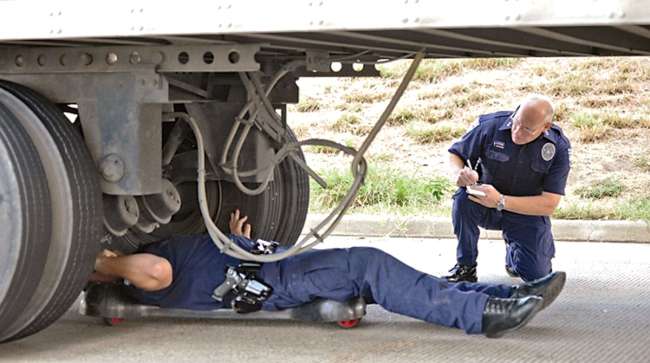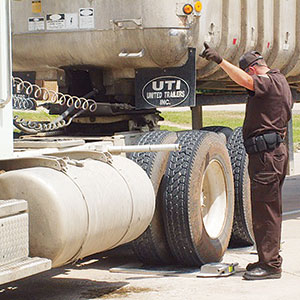Features Editor
Like Motor Carriers, Truck Insurers Await Changes to Federal CSA Program

With potentially big changes coming to the federal Compliance, Safety, Accountability program, insurance companies are hoping for a better way to identify unsafe motor carriers in an environment where insurers may be paying out much higher claims under the current system while some carriers are battling skyrocketing premiums.
LIVEONWEB: Program examines lowering insurance costs and managing risk
“CSA is definitely having an impact on premiums and on insurance companies deciding whether even to quote truckers,” said Duke Tomei, executive vice president and transportation practice leader at USI Insurance Services, an insurance broker, noting there’s a lot of doubt concerning the correlation of CSA scores to accidents.
The Federal Motor Carrier Safety Administration is evaluating possible sweeping changes to the CSA program’s Safety Measurement System used to identify carriers at high risk for future crashes.
Tomei said he hopes the next version of CSA will state that some criteria, such as certain vehicle maintenance issues, “don’t directly tie to being an unsafe motor carrier and will be a better predictive model of an unsafe motor carrier.”

Mikolay
Bert Mayo, vice president of risk solutions, transportation, at TrueNorth Cos., another insurance broker, said that overall, the exodus of insurers in commercial auto liability insurance in recent years, in addition to the current CSA score issues, means prices are going up.
Chris Mikolay, vice president of national accounts and truck alternative risk at National Interstate Insurance Co., which insures for-hire trucking fleets and offers traditional insurance and captive programs, said that the severity of claims has increased dramatically in recent years.
What might have been a $200,000 claim five years ago is now up to $500,000, Mikolay said, citing a more litigious environment and noting the industry continues to lose money on truck insurance.

Mayo
Meanwhile, insurers are scrutinizing CSA’s Behavior Analysis and Safety Improvement Categories, or BASICs, Mayo said.
Just over a year ago, if a motor carrier had two BASIC alerts, it wasn’t too difficult to get new insurance or to renew their current coverage, Mayo said. A year later, however, carriers with two or three alerts “are really struggling” to get insurance, or are paying very high premiums.
“The stake in the ground that has caused this shift is the recent nuclear verdicts,” Mayo said. Insurers “have gotten several years worth of data proving that higher CSA scores lead to higher claims.”
This has nothing to do with the true safety of a motor carrier, Mayo said, but plaintiffs’ attorneys use these CSA scores as indicators, “flying them around a courtroom, and a jury is not understanding what they really mean, and making awards based off of high CSA scores.”
A fleet executive offered his perspective.
“Carriers that have good safety performance are not getting increases,” James Burg, president of James Burg Trucking Co., an 80-truck fleet based in Warren, Mich., told Transport Topics. Burg is chairman of the insurance task force at American Trucking Associations and a member of ATA’s safety policy committee.
However, the frequency of roadside inspections is limited, Burg said. “Basically, there is not enough enforcement of the current rules.”

High CSA scores are influencing jurors, who often don't know what the scores mean, insurance experts argue. (Jamie Rector/Bloomberg News)
Burg added that 70% of all motor carriers in North America operate five or fewer trucks, and the minimum number of inspections is three to populate any BASIC.
“There’s just no possible way that most of the motor carrier capacity can have enough inspections to have enough data to determine if they are safe or not,” Burg said.
In many cases, BASIC scores have no direct correlation to a carrier’s risks, Mayo said. That means a carrier can have a high BASIC score in driver fitness or maintenance but have no accidents or crashes.
“Having a light out, or a cracked windshield, or one wiper blade not working — these things are not proven to have any correlation to a crash,” Mayo said.
Motor carriers can be on alerts for months. “Once you’re on the CSA ‘naughty list,’ more attention is drawn to you,” Tomei said. “You’re likely to stay on the alert and have more inspections.”
Having a light out, or a cracked windshield, or one wiper blade not working — these things are not proven to have any correlation to a crash.
Bert Mayo, insurance broker TrueNorth Cos.
Each BASIC has its own threshold, Mayo said. For example, the threshold for maintenance is 80. If it’s 79, the insurance company doesn’t care, but if it hits 80, “it goes to alert,” he said. “Now, the insurance company cares, and your insurance premium is drastically different.”
Jerry Gillikin, executive vice president at insurance broker Hub International, said that if a motor carrier has two or three BASIC alerts, a high Inspection Selection System (ISS) score or an FMCSA conditional rating, an insurer “may not even consider them.” The ISS score is an algorithm made up of a motor carrier’s BASIC scores, Gillikin said.
With a conditional rating or losses that are higher than average, Hub is seeing rates as high as $18,000 to $20,000 per truck for insurance in those situations, Gillikin said.
Insurers typically review a carrier’s CSA scores 60 to 120 days prior to that carrier’s renewal, USI’s Tomei said. “Are your scores in a positive direction or a negative direction? It’s the first thing they look at,” he said.
Tomei said USI starts the insurance renewal process soon after the current policy was bound. “Motor carriers should work with their insurance brokers well in advance of their normal renewal start dates.”
Tommy Ruke, founder of the Motor Carrier Insurance Education Foundation, said CSA scores have become a major underwriting factor.
There’s more data and detail than ever before on a motor carrier’s on-road activities, Ruke said.
Like Mayo, Ruke noted plaintiffs’ attorneys are using this information against motor carriers in court.

An Oklahoma state trooper inspects a truck. (Oklahoma Highway Patrol)
“From an underwriting standpoint, we also have to use that as a criteria of who we choose to write insurance with — so there’s a direct correlation between those two,” Ruke said.
Steve Bryan, founder and former president of Vigillo, which was acquired by SambaSafety in 2017, said his company has seen many cases of high premiums, “and even refusal to insure based on the current CSA scores over the last decade.” Bryan is now executive vice president and general manager of SambaSafety Transportation.
Earlier this month, SambaSafety announced a new CSA scorecard to address the Item Response Theory model, a data methodology that FMCSA is considering as it works to revamp the CSA program.
As for a timeline on the CSA program changes, Bryan said FMCSA has stated that it’s beginning “small scale testing.”
“We had the model developed to that point a few months ago and are now ready to roll it out to the entire industry as a preview,” Bryan said, noting FMCSA has said it’s targeting September 2019.
On the bright side, National Interstate’s Mikolay said that for fleets with more favorable loss history and more favorable CSA scores, “there’s competition for those better accounts.”
He added that cameras in a truck — facing inside and outside — are saving fleets money and can provide a high return on investment, if done right. “Cameras can be a powerful tool to help mitigate and contain your cost of risk.”
Overall, Burg said that insurance companies “are in a unique position,” noting they can analyze who is at risk, and who’s not. An insurer can audit a motor carrier’s safety programs and get an idea whether it cares about safety and whether it’s acting accordingly, Burg said.
In the meantime, the experts offered some tips for motor carriers to try to lower their insurance and related costs.
National Interstate’s Mikolay said motor carriers should consider how much risk is appropriate for them to retain and the right mechanism to do so, whether it’s a large deductible, a captive program or some other type of alternative risk program.
When a fleet starts to take on more risk, they get serious about safety, Mikolay said. “We generally see a safer culture because they’re not just transferring the risk to someone else. Now, they are on the hook for what can be a substantial amount of money if they’re not able to control their losses.”
Gillikin said choosing a deductible of $25,000, $50,000 or more is one way to minimize premiums and dependence on the insurance market in general. Taking a sizable deductible means a motor carrier is responsible for all claims that fall below their deductible level, he said.
“There is a collateral required for this alternative, but you save the premium up front,” Gillikin said.
As for captives, a type of alternative risk program, he said more of Hub’s clients have moved in that direction.
In general, a fleet with a “healthier” balance sheet should be thinking about a captive program, Mikolay said.




